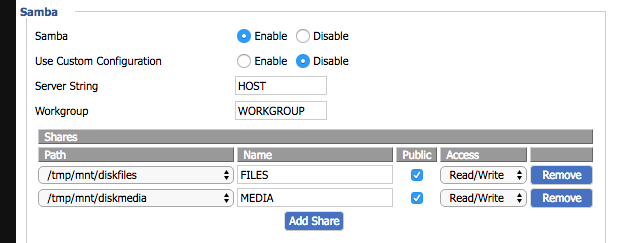

- #RASPBERRY PI BITTORRENT TRANSMISSION AND SAMBA HOW TO#
- #RASPBERRY PI BITTORRENT TRANSMISSION AND SAMBA UPDATE#
- #RASPBERRY PI BITTORRENT TRANSMISSION AND SAMBA DOWNLOAD#
- #RASPBERRY PI BITTORRENT TRANSMISSION AND SAMBA TORRENT#
You absolutely need some sort of anonymizing proxy or VPN system in place in order to use BitTorrent safely. In addition, if you’re not overly familiar with the ins and outs of setting up a BitTorrent client for anonymous downloading, you should read up on it.
#RASPBERRY PI BITTORRENT TRANSMISSION AND SAMBA HOW TO#
RELATED: How To Anonymize and Encrypt Your BitTorrent Traffic
#RASPBERRY PI BITTORRENT TRANSMISSION AND SAMBA DOWNLOAD#
the second tutorial is optional (but remote access is incredibly handy to have for this project, as a download box is a perfect candidate for a headless build), and the most important part of the third tutorial is simply setting up the hard drive and configuring it to auto-mount on boot (as described in the third guide).
How to Turn a Raspberry Pi into a Low-Power Network Storage DeviceĮverything in the first tutorial is necessary. How to Configure Your Raspberry Pi for Remote Shell, Desktop, and File Transfer. Everything You Need to Know About Getting Started with the Raspberry Pi. If you need to get up to speed in these areas, we strongly suggest reading the following guides in the order we have them listed here: What You Needįor this tutorial, we assume that you have a Raspberry Pi unit with Raspbian installed, are able to access the device either directly via an attached monitor and keyboard or remotely via SSH and VNC, and that you have an external USB drive (or drives) attached to it. If that sounds good, read on as we show you how to turn your Pi into a totally remote-controlled downloading machine. With torrents, the more you monitor the cloud and seed into it the better your ratio on your tracker (even if you’re leeching from public trackers, an always-on machine ensures you’ll be there when those rare files make an appearance). that will backup the configuration files for easy restore.Plus, when it comes to downloading torrents, an always-on machine is king. that allows access to the files remotely, and. that is a good citizen that will seed torrents, and. that provides access to a web UI both on the LAN and through the internet, and. var/lib/transmission/.config/transmission-daemon/settings.json \ #RASPBERRY PI BITTORRENT TRANSMISSION AND SAMBA UPDATE#
Update the backup file: /etc/openvpn/client \ Unmount with fusermount3 -u ~/Mount/piserver/torrent.
( Compression=no did not help CPU usage nor transfer speed - limited at 100 Mbit/s. delay_connect Connect when the directory is first opened. We can mount the directory on the PiServer with sshfs -o auto_unmount,kernel_cache,auto_cache,delay_connect piserver:/mnt/pistorage/torrent ~/Mount/piserver/torrent We create the mount directory on our normal devices (not the PiServer) for our user: ~/Mount/piserver/torrent. Neither NFS nor Samba are particularly secure (or the secure variants are a pain to set up), so we will use SSHFS which will allow us to access the completed files from any device that we can SSH in from. #RASPBERRY PI BITTORRENT TRANSMISSION AND SAMBA TORRENT#
The torrent client can seed much more effectively if you have an open port that allows new, incoming connections from other peers.
TODO: Change this to TCP localhost:9091ĮxecStart=/usr/bin/socat -d UNIX-LISTEN: '/run/transmission.sock,mode=0770,group=http,fork' exec: 'ip netns exec vpn "socat STDIO TCP-CONNECT:127.0.0.1:9091,nodelay",nofork,pipes' Restart= on-failure. A socket could be a TCP socket, a Unix socket, or something else. Socat, like the name suggests, can connect sockets together. Otherwise -d lets you use USB storage easily. Mkfs.f2fs needs benchmarking for optimal settings if you want. Therefore, we should increase these buffer sizes sudoedit /etc/sysctl.d/nf _max = 4194304 Modify /etc/openvpn/client/move-to-netns.sh with vpn -> "$NETNS_NAME" and if [ -z $. To run a single application through the VPN rather than the entire system, we can use network namespaces. Something something split-tunneling not going to do it? The data storage directory will be accessible only to specific users. The web interface will be secured with HTTPS and will be accessible over the LAN only. It will operate inside a VPN (using OpenVPN) that forwards exactly one port. It will have access to only its own files and a special data directory. Transmission will run as its own user transmission. (Alternatives might include rtorrent or deluge.) Security This will allow the peer-to-peer torrent traffic to be more securely segmented from other services that you may run, and only have access to one open incoming port. 

We will set up a service that works through a VPN that uses the data storage area of the Pi with a secure web interface to manage it. Transmission is a simple, no-frills torrenting application with different GUI, CLI and web interfaces.







 0 kommentar(er)
0 kommentar(er)
